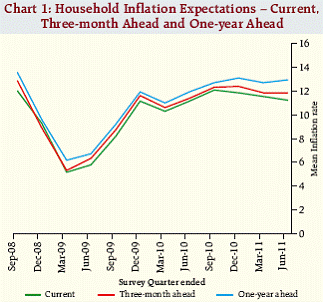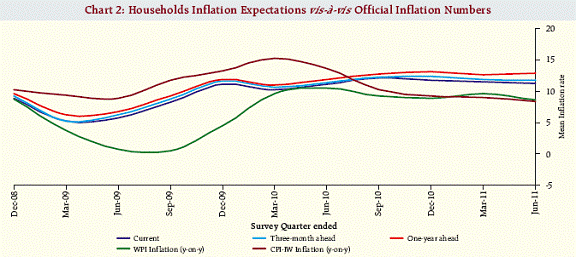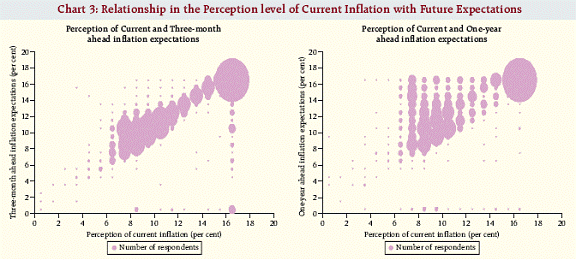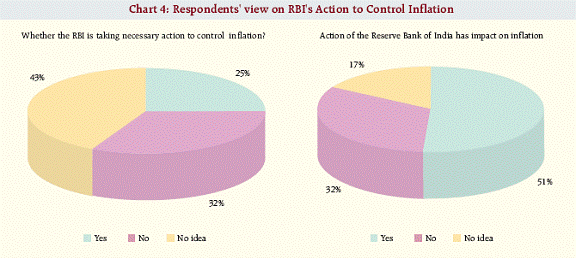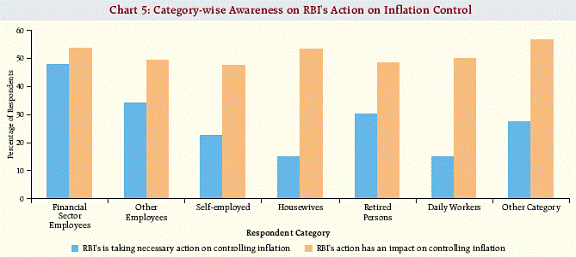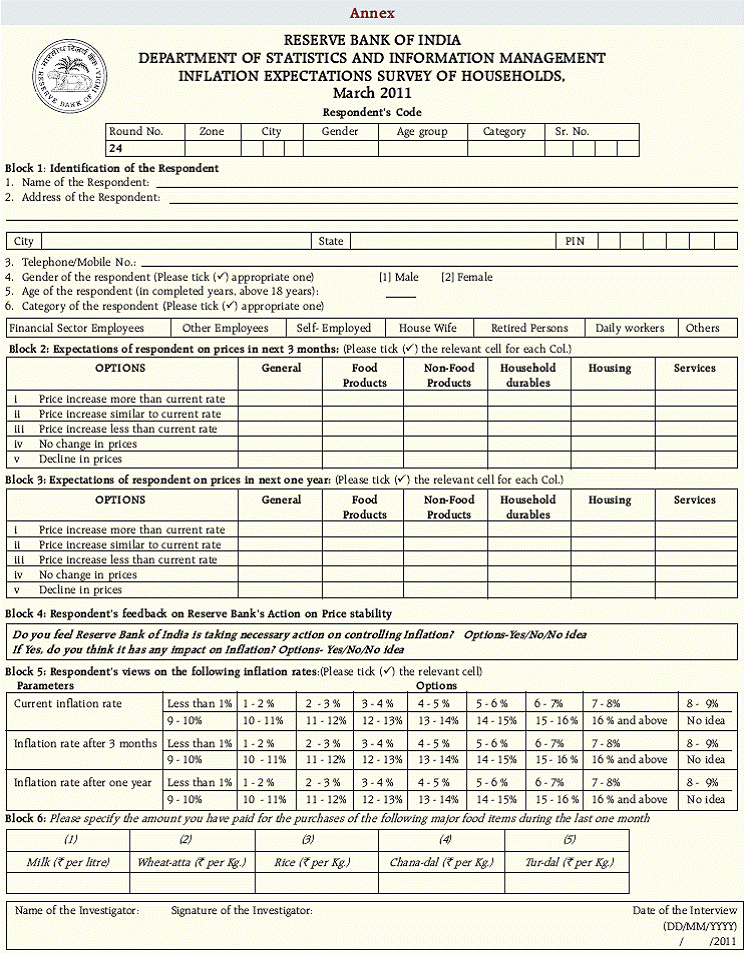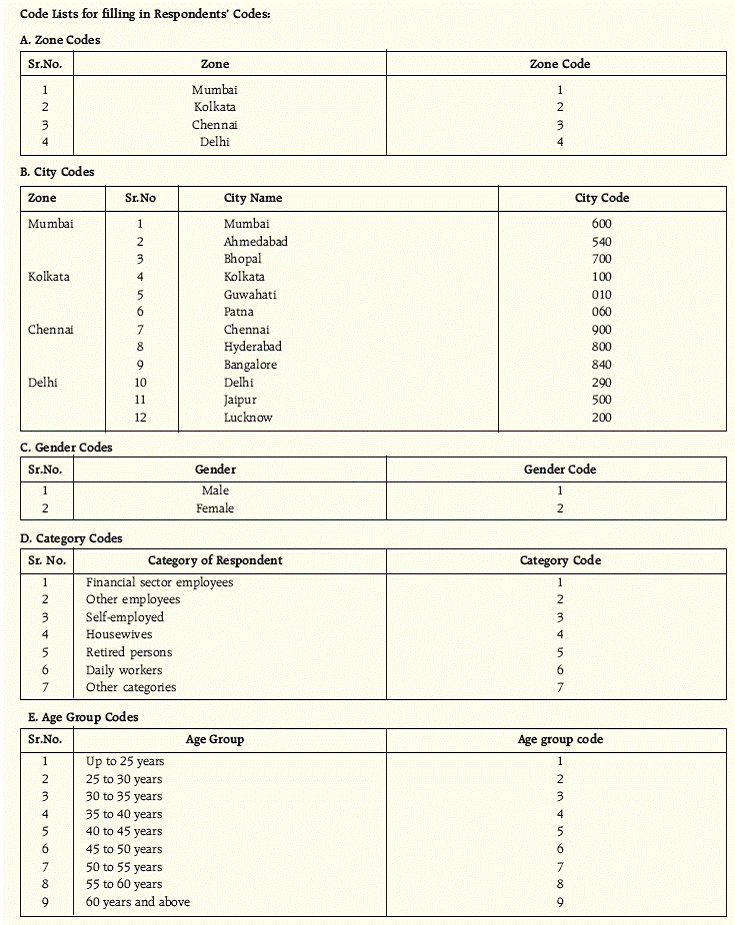Inflation Expectations Survey of Households: June 2011(Round 24) - आरबीआय - Reserve Bank of India
Inflation Expectations Survey of Households: June 2011(Round 24)
Inflation Expectations Survey of Households: June 2011 (Round 24)* This article presents the findings of Inflation Expectations Survey of Households conducted in the April - June 2011 quarter, the 24th round in the series. The survey captures the inflation expectations of 4,000 urban households across 12 cities for the next three months and for the next one year. These expectations are based on their individual consumption baskets and, hence, these rates should not be considered as predictors of any official measure of inflation.The households’ inflation expectations provide useful directional information on near-term inflationary pressures and also supplement other economic indicators to get a better indication of future inflation. The survey results are those of the respondents and not necessarily shared by the Reserve Bank of India. The current round of the survey shows that the threemonth ahead inflation expectations of households have tended to be slightly lower at 11.8 per cent from 11.9 per cent in the last round of survey but one-year ahead inflation expectations have moved slightly higher at 12.9 per cent from 12.7 per cent. The survey findings indicate that households expect inflation to rise further by 60 and 170 basis points during next three-month and next one-year period respectively, from the perceived current rate of 11.2 per cent. The percentage of respondents expecting price rise have gone up for all product groups (viz., food, non-food, household durables, housing and services). However, expectations on general price rise were mainly influenced by movements in food prices. On category-wise inflation expectations, daily-wage workers and housewives expected higher inflation rates compared to other categories. Across the cities, Bangalore expected the highest inflation while expectations were the lowest for Hyderabad. 25 per cent of the respondents felt that RBI is taking necessary action to control inflation, of which, 51 per cent felt that RBI’s action has an impact on controlling inflation. I Introduction Reserve Bank of India has been conducting Inflation Expectations Survey of Households (IESH) on a quarterly basis, since September 2005. The survey elicits qualitative responses on expected price changes (general prices as well as prices of specific product groups) in the next three-month as well as in the next one-year and quantitative responses on current, threemonth ahead and one-year ahead inflation expectations. Inflation expectations of households are subjective assessments and are primarily based on their individual consumption baskets and, therefore may be different from the official inflation numbers released periodically by the government. II Data Coverage and Methodology The survey schedule (Annex) designed for the IESH has been organised into six blocks. The first block seeks respondents’ particulars including name, contact details, gender, age and occupation (category). The second and third blocks seek product-wise price expectations for three months ahead and one year ahead, respectively. The fourth block assesses the respondents’ feedback on the Reserve Bank’s action to control inflation. The fifth block collects the rate of inflation of the respondent for three time points - current, three-month ahead and one-year ahead. The last block captures the information on the amount paid by the respondents for the purchase of major food items, viz., Milk (per litre), Wheat-atta (per kg), Rice (per kg), Chana dal (per kg) and Tur dal (per kg) during last one month. II.1 Data Coverage The Reserve Bank conducts this survey in 12 cities on a quarterly basis. The major metropolitan cities, viz., Delhi, Kolkata, Mumbai and Chennai are represented by 500 households each, while another eight cities, viz., Jaipur, Lucknow, Bhopal, Ahmedabad, Patna, Guwahati, Bangalore and Hyderabad are represented by 250 households each. The respondents are well spread-out across the cities to provide a good geographical coverage. The proportion of male and female respondents in the current round of the servey is in the ratio of 3:2. The category-wise representation of the respondents is presented in Table 1. The sample coverage is nearly as per the target in all rounds. II.2 Information Collected The price expectations are sought for general prices and for five product groups (food products, nonfood products, household durables, housing and services). The general price comprises prices of all the product groups taken together. The options for responses are (i) price increase more than current rate, (ii) price increase similar to current rate, (iii) price increase less than current rate, (iv) no change in prices and (v) decline in prices. The first three of the five options pertain to the respondents’ expectations on the rate of future price increase compared to the current rate. These expectations are sought from the respondents for three-month ahead as well as one-year ahead period. The inflation expectations of the respondents that represent the year-on-year changes in prices are collected through Block 5. The inflation rates are collected in intervals – the lowest being ‘less than 1 per cent’ and the highest being ‘16 per cent and above’ with 100 basis point size for all intermediate classes. The information on the respondents’ awareness on the Reserve Bank’s action to control inflation as well as the impact of the Reserve Bank’s action on inflation is obtained in Block 4 from the 21st survey round (quarter ended September 2010). From the 22nd round (quarter ended December 2010), a question was added in Block 6 to capture the information on the amount paid by the respondents for the purchase of major food items, viz., Milk (per litre), Wheat-atta (per kg), Rice (per kg), Chana dal (per kg) and Tur dal (per kg) during the last one month.
III Survey Results III.1 General Price Expectations The survey results show that the percentage of respondents expecting increase in general prices for both three-month ahead and one-year ahead period have gone up in the latest round. The proportion of respondents in each of these response categories in the last 10 rounds is presented in Table 2. The percentage of respondents expecting price increasec over the next three-month ahead and one-year ahead period have both increased to 98.7 per cent from around 96.0 per cent in the previous round (January- March 2011). However, for both these periods, the proportion of respondents who expect this price increase to be ‘higher than current rate’ has fallen marginally from the proportions registered in last round of survey, but the proportion of respondents who expects this price increase to be ‘less than current rate’ have increased in respect of previous quarter. III.2 Product Group-Wise Price Expectations The product group-wise price expectations are given in Statement I. For three-month ahead and oneyear ahead price expectations, the percentage of respondents expecting increase in prices has gone up for all product groups, viz., food products, non-food products, household durables, housing and services. For the three-month ahead period, in case of food and non-food products prices, there has been a reduction in percentage of households which perceive price increase ‘similar to the current rate’. However, the proportion of households which expects price increase ‘more than the current rate’ has gone up. In case of household durable prices, the proportion of households expecting price increase ‘more than the current rate’ and ‘similar to the current rate’ has gone up as compared with the previous round. Similarly, vis-à-vis the last round of survey, more households expect housing prices and cost of services to increase at lower than the current rate. III.3 Coherence Between General Prices and Product Groups’ Prices General price expectations are influenced by the price expectations in respect of various product groups. However, price expectations of certain product groups can influence the general price expectations more than other products. Therefore, a measure of coherence between general prices and prices of various product groups was derived based on the total percentages of respondents who expect similar movements in general price and those of various product groups. This degree of coherence between general price and prices of various product groups for three-month ahead and oneyear ahead period is depicted in Table 3 and Table 4. As in the past rounds, the general price expectations are more aligned with food price expectations as compared to other product groups. This association was the lowest with household durables prices. In the current round of the survey, about 88.5 per cent and 94.8 per cent of the respondents are seen to have been influenced by changes in food prices for arriving at three-month ahead and one-year ahead general price expectations respectively. The extent of coherence between general price expectations and that of other product groups has, by and large, increased in the current survey round as compared with the previous round. III.4 Inflation Expectations The perception on current inflation rate and expectations for three-month ahead and one-year ahead inflation since round 12 (September 2008) are presented in Table 5 and Chart 1. It represents the average of inflation rate reported by 4,000 households. The current round of the survey shows that the threemonth ahead inflation expectations of households have tended to be slightly lower at 11.8 per cent from 11.9 per cent in the last round of survey but one-year ahead inflation expectations have moved slightly higher at 12.9 per cent from 12.7 per cent. The respondents’ view of the current inflation and the three-month ahead expected inflation in the current survey round have declined by 30 and 10 basis points, respectively, whereas one-year ahead expected inflation rate has increased by 20 basis points vis-à-vis corresponding average rates reported in the previous round. The survey findings also indicate that households expect inflation to rise further by 60 and 170 basis points during next three-month and next one-year, period respectively, from the perceived current rate of 11.2 per cent. Though these inflation expectations provide useful inputs on directional movements of future inflation, these are not to be treated as forecast of any official measure of inflation.
It may be seen from Chart 1 that the short and long-term expectations corresponding to three-month and one-year ahead periods lie above the perceived current inflation rates.
Chart 2 depicts the household inflation expectations along with the official inflation measures based on Wholesale Price Index for all commodities (WPI) and Consumer Price Index for Industrial Workers (CPI-IW). For a large part of the survey history, the households’ inflation expectations remained between the WPI and CPI-IW inflation rates. However, from September 2010 round of the survey, household inflation expectations are higher than the official inflation rates. In the current round also, the same trend has been observed. III.5 Volatility in Responses Over different rounds of the survey, the volatility in the responses in terms of standard deviation has been observed to be lower for current inflation rate as compared to three-month ahead and one-year ahead expected inflation rates (Table 6).However, in the latest round, the volatility in all the three periods were more or less at the same level.
The total variability in responses for inflation expectations may partly be explained by different classificatory factors (viz. gender, age-group, city and category) of respondents over different rounds. An Analysis of Variance (ANOVA) carried out over different rounds revealed that ‘city’ has always been a significant source of variation in each round (Table 7).Category of the respondents has also been observed to be a significant source of variation particularly since last one year. This may be due to variation in consumption baskets across the cities and across the categories of the respondents. III.6 Gender-wise Expectations In the current round of survey, though female respondents expected marginally higher inflation rates as compared to their male counterparts, the analysis finds no significant difference between male and female respondents’ responses for current, threemonth ahead and one-year ahead periods (Table 8). III.7 Category-wise Expectations The category of respondents indicates their occupation status. For the latest survey round, daily workers and housewives reported higher inflation expectations whereas financial sector employees expected lowest inflation (Table 9). III.8 Age Group-wise Expectations The survey covers only adult respondents of 18 years or more. During the current survey round, the respondents in the age group ‘up to 25 years’ and ‘55 year and above’ are found to expect the highest inflation rates for the three-month ahead and one-year ahead periods (Table 10). However, in other age group, no specific pattern is observed in inflation expectations. III.9 City-wise Expectations Significant variations are observed in the inflation expectations across different cities, which may be attributed to the divergence in consumption pattern between cities. In the latest round of survey, current inflation was found to be the highest in Jaipur and the lowest in Patna. However, for three-month ahead and one-year ahead periods, households in Bangalore expected the highest and households in Hyderabad expected the lowest inflation (Table 11). The variability in responses was the highest in Ahmedabad and the lowest in Patna for the current inflation. III.10 Cross-tabulation of Current Inflation and Future Expectations The distribution of inflation expectations expresses the degree of respondents’ optimism on future price movement vis-à-vis current price changes. The cross-tabulation depicting the relationship between the current and future inflation expectations for three-month and one-year ahead period are presented in Table 12 & Table 13 and the same is depicted in Chart 3 also. It may be observed that 52.8 per cent respondents perceived double-digit current inflation. Similarly, 71.5 per cent and 81.4 per cent of the respondents expected the double-digit inflation rates for the three-month ahead and one-year ahead periods. A cross-tabulation of the current inflation perception with the future inflation expectations points out that among the 52.8 per cent (66.3 per cent in previous round) respondents who perceived the current inflation in double-digit, 95.5 per cent (93.7 per cent in previous round) and 96.8 per cent (92.3 per cent in previous round) respondents expected that it would remain in the same level for three-month ahead period, and one-year ahead respectively.
III.11 Awareness on Reserve Bank of India’s Action to Control Inflation An additional block (Block 4) was added to the survey schedule from the 21st round (September 2010) to gauge the awareness of public on Reserve Bank’s action on inflation control. Out of the two questions in this block, the first one elicits the respondent’s awareness whether the Reserve Bank is taking necessary action for controlling inflation whereas the second one seeks whether the respondent thinks that the Reserve Bank’s action has any impact on inflation. The responses for the latest survey round are presented in Chart 4. 57 per cent of households felt that the Reserve Bank is taking action to control inflation. Of these, 25 per cent of the respondents felt that the Reserve Bank is taking necessary action to control inflation. Out of these 25 per cent respondents, 51 per cent felt that the Reserve Bank’s action has an impact on controlling inflation.
The category-wise distribution of the responses based on this block of the survey schedule shows that the awareness on the Reserve Bank’s action on inflation control is the most among ‘financial sector employees’ and was the least in case of ‘daily workers’ and ‘housewives’ (Chart 5).
The category-wise distribution of the responses on ‘the impact of RBI’s action on inflation control’ out of the 25 per cent respondents who felt that the Reserve Bank is taking necessary action to control inflation is presented in Table 14. IV A Bootstrap Confidence Interval for Inflation Expectations In the previous Sections, the average rates of inflation expectations are presented. As the exact distribution of the population variable under study, i.e., inflation expectations is unknown, bootstrap resampling method for statistical inference has been used to derive the interval estimates of the average inflation expectations of households.These confidence intervals for mean are presented to give an idea of the error associated with the estimates of households’ inflation expectations. Drawing 10,000 re-samples using simple random sampling with replacement from the sample of the survey, 99 per cent Bootstrap Confidence Intervals (BCI) for mean were obtained.The results are presented in Table 15. It is observed that the exercise leads to a confidence interval with a small width indicating that the point estimates are quite precise for estimating the population means of households’ expectations of inflation.
* Prepared in the Division of Household Surveys, Department of Statistics and Information Management. The previous article on the subject was published in June 2011 RBI Bulletin. |
|||||||||||||||||||||||||||||||||||||||||||||||||||||||||||||||||||||||||||||||||||||||||||||||||||||||||||||||||||||||||||||||||||||||||||||||||||||||||||||||||||||||||||||||||||||||||||||||||||||||||||||||||||||||||||||||||||||||||||||||||||||||||||||||||||||||||||||||||||||||||||||||||||||||||||||||||||||||||||||||||||||||||||||||||||||||||||||||||||||||||||||||||||||||||||||||||||||||||||||||||||||||||||||||||||||||||||||||||||||||||||||||||||||||||||||||||||||||||||||||||||||||||||||||||||||||||||||||||||||||||||||||||||||||||||||||||||||||||||||||||||||||||||||||||||||||||||||||||||||||||||||||||||||||||||||||||||||||||||||||||||||||||||||||||||||||||||||||||||||||||||||||||||||||||||||||||||||||||||||||||||||||||||||||||||||||||||||||||||||||||||||||||||||||||||||||||||||||||||||||||||||||||||||||||||||||||||||||||||||||||||||||||||||||||||||||||||||||||||||||||||||||||||||||||||||||||||||||||||||||||||||||||||||||||||||||||||||













